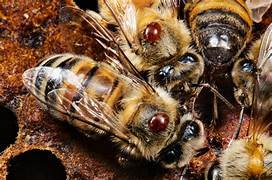Natural, Non-Chemical Ways to Manage Varroa Mites
Natural, Non-Chemical Ways to Manage Varroa Mites
Varroa mites (Varroa destructor) are one of the greatest threats to honeybee colonies, weakening hives by spreading viruses and depleting bee health. While chemical treatments can be effective, they may also introduce toxins into the hive and lead to mite resistance. At The Foraging Bee, we advocate for natural, sustainable beekeeping practices to manage mites while keeping colonies thriving. Here are some of the best non-chemical strategies to control Varroa mites.
Whatever it is, the way you tell your story online can make all the difference.
1. Brood Breaks (Queen Manipulation)
Varroa mites reproduce in capped brood cells, so interrupting the brood cycle can significantly reduce their numbers. Techniques include:
Caging the queen for a set period to pause brood production and break the mites' reproductive cycle.
Splitting colonies to simulate swarming, which naturally reduces mite loads.
Allowing natural swarming, though this requires careful hive management to prevent colony loss.
2. Screened Bottom Boards
Replacing solid bottom boards with screened ones allows mites to fall through and prevents them from climbing back onto bees. This is an easy, passive way to reduce mite loads over time.
3. Drone Brood Removal (Trap Frames)
Mites prefer drone brood because of its longer development time. Adding drone frames to the hive and removing them before drones emerge can help control the mite population naturally.
4. Powdered Sugar Dusting
Dusting bees with fine powdered sugar encourages self-grooming, making it harder for mites to cling to their hosts. This simple and effective method can be repeated throughout the season.
5. Essential Oils & Natural Repellents
Certain essential oils can help keep mites at bay while boosting bee health. Consider using:
Thymol (from thyme oil) to disrupt mite reproduction.
Lemongrass & spearmint oil to improve colony immunity and resilience.
6. Heat Treatment (Thermal Mite Control)
Mites are more heat-sensitive than bees. Devices like thermal mite controllers expose the hive to controlled heat levels, killing mites without harming the colony.
7. Small Cell or Natural Comb Beekeeping
Allowing bees to build their own comb naturally results in smaller worker cells, which shorten development time and give mites less opportunity to complete their reproductive cycle.
8. Breeding for Resistance
Selecting Varroa-resistant bees is a long-term strategy that improves colony resilience. Hygienic bee strains include:
Russian Bees
Tasmanian Bees
9. Open Mating with Survivor Stock
Breeding local survivor colonies enhances natural resistance over time. By capturing and propagating swarms, beekeepers can foster stronger genetic lines.
10. Hive Location & Stress Reduction
A diverse forage environment and minimal pesticide exposure contribute to overall bee health, making colonies better equipped to manage Varroa infestations naturally.
Integrated Approach is Key
No single method will eliminate Varroa mites entirely, but combining multiple techniques increases success. A well-rounded, integrated pest management (IPM) approach helps bees stay strong and resilient.
Join Us at The Foraging Bee for Sustainable Beekeeping!
At The Foraging Bee, we’re passionate about natural, eco-friendly beekeeping. Follow me at Edu-🐝 to learn how to manage your hives sustainably, from Varroa control to honey harvesting.
🐝 Let’s Bee Curious Together! Sign up for our next workshop and help build a healthier future for our pollinators.
Visit The Foraging Bee to Learn More!


